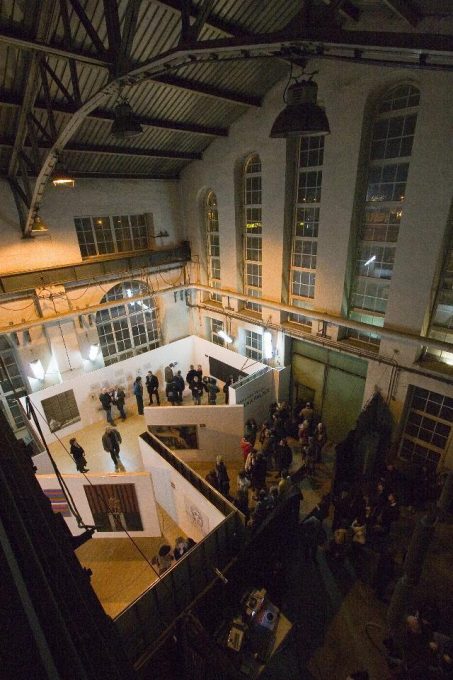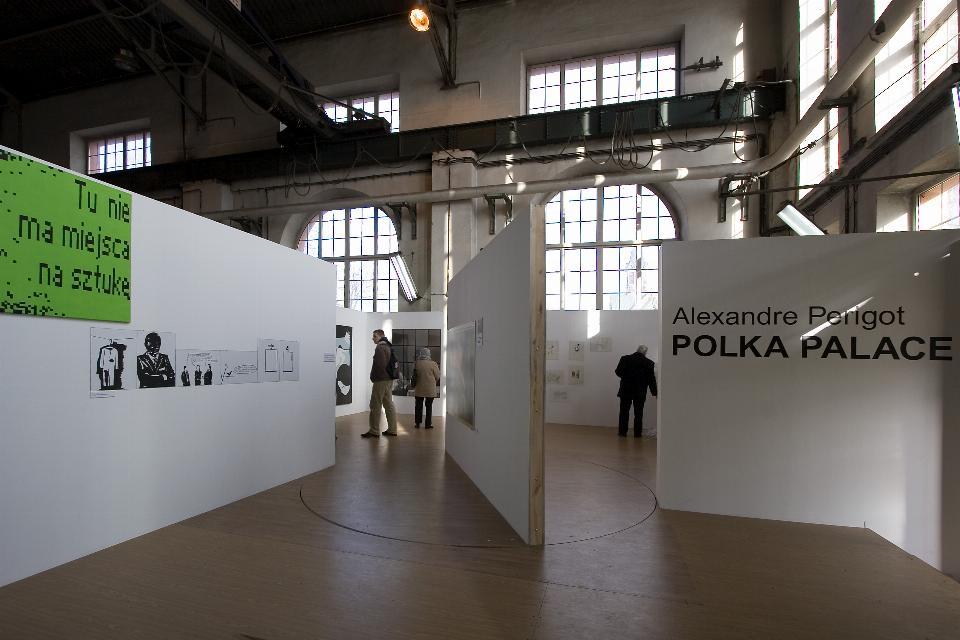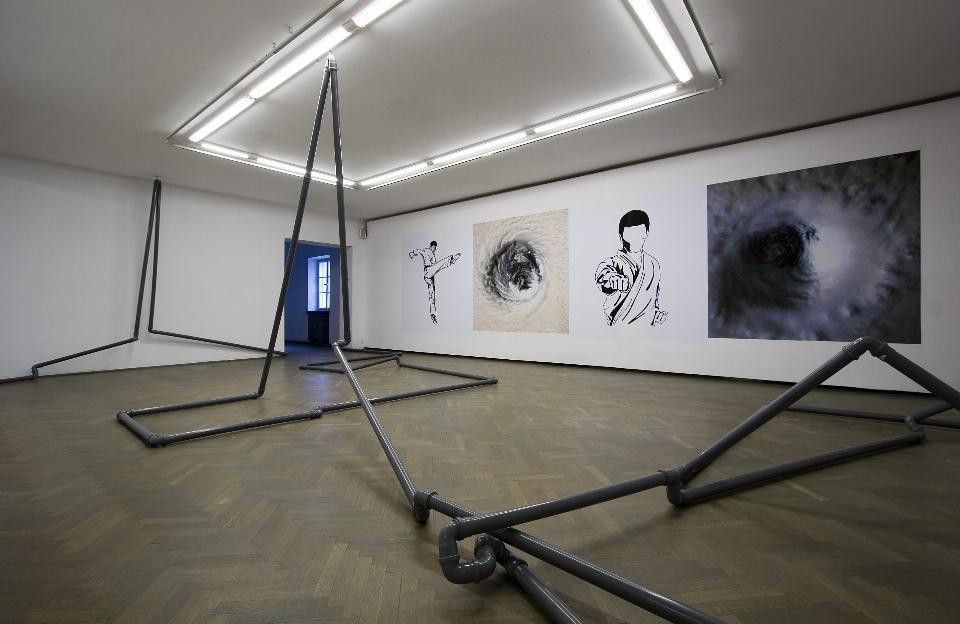ALEXANDRE PERIGOT – Polka Palace
Polka Palace is Alexander Perigot’s artistic proposal. Polka Palace is the third version of triptych, the installation in the form of a moving labyrinth with the area of 200 m2. The following project can be adopted depending on the size of the exhibition area.Three versions of a triptych:Prototype: 3bisf Aix-en-Provence, 2005First version : POPEYE PALACE, La Criée Art Centre, Rennes France, 2006Second version : BORDER PALACE, Istanbul Biennale Turkey, 2007.Third version – POLKA PALACE, Gallery Arsenal Bialystok Poland, 2008.The project Polka Palace will be presented at Museum Berardo in Belém Cultural Centre (CCB) Lisboa, September 2008.Introduced work is presented in a different configuration in each part of the exhibition’s area. Technical drawing of the moving labyrinth.
In the first form, the moving labyrinth was constructed in Rennes, France in 2006. The work, which was titled Palaispopeye (the Popey’s Palace), composed of five movable platforms with the walls on them, where the photo in a form of Photo wallpaper presenting the script of Robert Altman’s film “Popeye”, was placed. The photo was divided into frames, which depending on the configuration of the movable platforms that puts the still image into movement, was folding and unfolding. What is more, system decomposition and image overlapping, that is typical of a film screening, in Alexander Perigot’s installation, adapts contrary form. The artist clearly argues with Gilles Deleuze’s cinema theory. This French philosopher analyses the category of movement – image and time – image and subsequently the consequences they bring to the object of culture. The movement-image of the cinema as the classical cinema, allows the viewer to resign from occupying one’s own central position in today’s world, and as a consequence one resigns from human recognition constraints. The cinematic images give us the opportunity to see the world without the need of our presence. Furthermore, without the necessity of taking the trouble of any activity, they offer the contemplation on the image – world flowing on the screen. The cinema of time – image, modern cinema, is regarded as the fulfillment of consciousness image and not only does it break the sensual – motor bonds of the viewer, but also of a film character. Time becomes the superior category to movement. Cinematograph, while introducing the phenomenon of screen, presented new kind of a recipient – viewer, who by resigning from one’s own images created by sensual faculties, adopts the images generated by the screen. Alexander Perigot’s labyrinth allows this situation to be averted. Thanks to the turning platforms the object is placed in the centre of the image creation what results in the change of point of view and reference point. The object is no longer a passive viewer but is aware creator and at the same time recipient of the image created in the movement. Photos were presented as a whole in a form of a billboard by Alexander Perigot on the Venice Biennale in 2004.
Second version of the project was carried out in Biennale in Istanbul in September 2007. This time, there was no photo wallpaper applied on the walls. Movable walls, made of plaster, composed the severe stage design for musical installation. Musicians from the former Eastern Bloc countries were invited to the musical project Sondborders by Alexander Perigot. As a result, musical boundary is marked from Esthonia to Azerbaijan. Rock, punk and ethnic music compilation invites to the discussion relating to the political point of contemporary Europe, which becomes more and more scarcely historical and cultural heritage. Europe, as being limited to the economic borders of the European Union, besides them, seeks its own identity.
In the third version the movable labyrinth will be altered into exhibition area. In its “walls” and on its walls selected works of contemporary art collection of Arsenal Gallery in Bialystok will be put. Polka Palace will be the movable art gallery in art gallery. Viewer of the exhibition will become its integral part. The movable installation will take him on a tour of the world of art. Each fragment of a free area is a designed work. There are works of Alexander Perigot in places where the works of a collection are not displayed. The problem of a classical method of exhibiting the collection, where the single works are arranged in a whole exhibition, are placed in a new context, confronted with the work they include. It will not be the architecture of the exhibition hall, frequently not neutral and indifferent to the works shown there. In the case of Polka Palace, particular viewer deals with a double game, with a work of art, Gallery and an artist. The problem concerning gallery’s artistic activity promotion will be treated ironically, as a place in ‘a funfair’, where the viewer on a merry-go-round will forget about the “serious” character of the national art gallery. While selecting the Arsenal’s collection, the artist was induced by previous cooperation with the Gallery in Bialystok. In January 2008 the artist will show the retrospection of his works from the years 2000-2007. Polka Palace will take place in the old power electric station, to transfer temporary the Gallery Arsenal activities in a new place. Moreover, the whole project will be financed by the Cultures France and The French Embassy in Poland.
‘… II Collection deserves special attention, due to the fact that the area of its interests includes the worst and most neglected period for the Polish collection. What is more, its essential value is made by debut or early works of artists, who are completely disregarded by the museum institutions owing to their age and total oeuvre. In addition to this, the gallery acted as a professional collector who invests in the future and counts on the increase in value of the young artist’s works, by obtaining in a suitable time to its collection the works of such artists as Robert Maciejuk, Zbigniew Libera, Marta Deskur, Cesary Bozianowski, Kobas Laksa, Hubert Czerepok, Katarzyna Kozyra, Dorota Nieznalska or Zbigniew Rogalski. The collection simultaneously gains in supplementary value as an active initiative, promoting and supporting new phenomena, shaping unique values in art by contrast with the traditional collections predisposed towards restoration and status quo reflection. Consequently, exhibitions held in the country and abroad are favorable to collection promotion”
Curator: Monika SzewczykCooperation from the gallery: Małgorzata Grygielewicz
Alexandre Perigot

PLAN YOUR VISIT
Opening times:
Thuesday – Sunday
10:00-18:00
Last admission
to exhibition is at:
17.30


